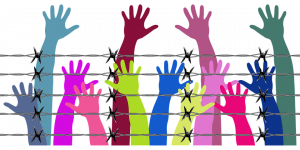
Social institutions powerfully impact how children move throughout the world—even if the institution is indirectly affecting them. Such is the case with parental incarceration and its effect on children and their transition to adulthood. And, of course, education is a major site of indirect inequalities. The research article, “Paternal Incarceration and Children’s Schooling Contexts: Intersecting Inequalities of Education Opportunity,” by Anna R. Haskins, describes the type of schools that children with incarcerated fathers attend. Her article highlights the ways in which mass incarceration has transformed schooling in the United States. What are the types of schools that children with incarcerated fathers attend? Who exactly teaches at these institutions? How do those learning conditions compare to the learning conditions of children with fathers who are not incarcerated? Haskins’ new study answers these questions.
The article uses data on children’s early elementary environments from a longitudinal birth-cohort sample of urban families. Specifically, The Fragile Families and Child Wellbeing Study is the longitudinal study that follows 4,898 children and their parents. A reminder of how this amazing data set was established: Data were collected from twenty large U.S cities between 1998 and 2000. Marital and non-marital births were randomly sampled within hospitals across cities. Mothers were interviewed in these hospitals 48 hours after the child was born, and the interviews for the fathers took place soon after. After these interviews, there were five additional follow-up waves of phone interviews that took place when the child was approximately 1, 3, 5, 9, and 15 years old. Specifically, these waves included interviews of the parents, in-home assessments of the child and their home environment (starting at wave 3); and when the child was 9 years old and had entered what the other called “formal schooling”, this was around wave 4, a teacher survey a large range of educational assessments, and administrative data from the child’s elementary school were collected.
And what we already know: Having an incarcerated parent already creates a disadvantage across a range of social, economic, behavioral and health outcomes. Therefore, since these students are possibly but in lower-income schooling, some research has demonstrated that schools that serve predominantly low-income and minority families disproportionately employ teachers with lower levels of education, nonstandard certifications, and fewer years of teaching experience. It was found that Black and Hispanic children in the Fragile Families Study are more likely than whites to experience paternal incarceration. Specifically, for Blacks, this reaches 57 percent by year nine, Hispanics at around 40 percent and Whites at nearly 30 percent. This means that nearly two-thirds of the Black children in the sample have had a father incarcerated at some point by the time they are only nine years old.
Focusing on the profile of the schools attended, there are significant differences in the types of schools and teachers at schools where children with incarcerated fathers attend. Children with incarcerated fathers by age nine are significantly more likely to attend a school that receives Title I funding. Title I funding is for schools with high rates of poverty. Their schools also have higher percentages of the student body eligible for free or reduced-priced lunch, larger concentrations of minority students, and more students in their classroom repeating the current grade. These are all indicators of poor school quality and show that children who have not had incarcerated fathers attend higher quality school systems. In addition, per the study, children with incarcerated fathers are significantly more likely to be in public school, but less like likely to have white teachers.
But, what is unique about this study was that even though prior research found that lower-income schools employ teachers with less experience—this research didn’t exactly find that. Interestingly enough, none of the teacher quality indicators, such as years of teaching experience, highest level of education, or elementary certification, differed between the paternal incarceration groups, nor did class size or school reports of student-teacher ratios. In other words, the teachers were up to the task, but the context the children lived in made things especially difficult for them.
Pertaining to schooling and behavior, there was strong evidence that showed children that experienced paternal incarceration attend schools in neighborhoods with more disorder, harsher disciplinary climates, and lower rates of a positive school climate, as reported by teachers.
So, what does all of this mean for children with their fathers separated from them and trapped behind bars? Paternal incarceration not only impacts children’s transition at home—but it also dictates their overall schooling experience. Set aside their behavior, paternal incarceration has a heavy correlation to the type of school they go to compared to their peers without incarcerated fathers. When reading this research, we find a serious the impact of just having one parent, the father, incarcerated—think about what this can do to a child if it was both of their parents. The transformative experience a child has to go through, not just in their home but at their school, should speak loudly about the enormous costs of hyper-incarceration in the U.S.
Tasia Clemons is a Senior sociology major at Framingham State University, an Administrative Resident Assistant, and a CCF Public Affairs Intern.

Comments